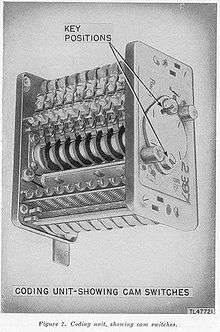FuG 25a Erstling
 An Erstling coding unit | |
| Country of origin | Germany |
|---|---|
| Introduced | 1941 |
| Type | Identification Friend or Foe (IFF) |
The on-board radio set FuG 25a Erstling (German: "Debut") was an identification friend or foe (IFF) system installed into Luftwaffe aircraft of World War II starting in 1941 in order to allow German radar stations to identify them as friendly. Developed by the GEMA company, it received impulses from German Freya or Würzburg radar stations and replied with a pre-defined signal. Later, the FuG 25a became a key component of the EGON night fighter guidance procedure.
Operation
The "Erstling" IFF transceiver was activated from ground stations by switching the pulse repetition frequency from 3,750 Hz to 5,000 Hz. The on-board device replied by sending a pre-programmed morse code signal on 156 MHz. The coding unit was a motor-driven cam switch encrypted with two ten-bit code keys.
Würzburg stations needed to be equipped with accessory units, namely a query transmitter code-named Q-Gerät ("Kuh", German "cow") and the identification receiver "Gemse" (German for "chamois").
Countermeasures
In the summer of 1944 the first British Mosquito aircraft were equipped with the "Perfectos", a device that activated the FuG 25a and triggered the response, which was detected to reveal the presence of the enemy aircraft. This severely curtailed the use of "Erstling", as German night fighter crews had to switch it off to avoid detection.[1]
Technical specifications
- Receiver: 125 MHz (Freya) and 550-580 MHz (Würzburg)
- Sensitivity: 2 mV
- Transmitter: 156 MHz
- Power: 0.2 Watt
- Activation: Radar pulses at 5000 Hz
- Encryption: 2x10 bit
- Range: 40 km (FuG 25z) and 270 km (FuG 25a)
| FuG 25z | FuG 25a | |
| Reception frequencies | 560 MHz | 125 ±8 MHz |
| Transmission frequencies | 560 MHz | 156 MHz |
| Transmission power | unknown | 400 W (PEP) |
| Current | 4 A DC | 4 A DC |
| Power supply | 24 V DC | 24 V DC |
| Weight | 11 kg | 17 kg |
| Tubes | 6xRV12P2000, 1xLD1 | 7xRV12P2000, 1xRG12D60, 2xLD1, 1xLS50. |
| Range | 72 km (40 miles | roughly 80% of visual range, max. 270 km (150 miles) |
Safeguards
The Luftwaffe was known for fitting sensitive devices like "Erstling" with small explosive charges to allow their destruction in order to avoid capture. A short fuse allowed the crew to reach a minimum safe distance.
See also
Literature
- Christian Möller, "Die Einsätze der Nachtschlachtgruppen 1, 2 und 20 an der Westfront von September 1944 bis Mai 1945", ISBN 978-3-938208-67-0
- Fritz Trenkle, "Die deutschen Funkführungsverfahren bis 1945", Dr. Alfred Hüthig Verlag Heidelberg, 1987, ISBN 3-7785-1647-7
- Werner Gierlach, "Flugmeldedienst", issue 8, Freya-Fibel, pages 43-44), Cologne
- TME 11-219 Directory of German Radar Equipment
External links
- Description and pictures of FuG 25a (partly in German)
- Fighter control stations
- Training manuals of the "Jagdschloss" aerial signals training facility (PDF) (German)
- More "Jagdschloss" pictures
References
- ↑ Gebhard Aders, Geschichte der deutschen Nachtjagd, Motorbuch publishing company 1977, p. 303